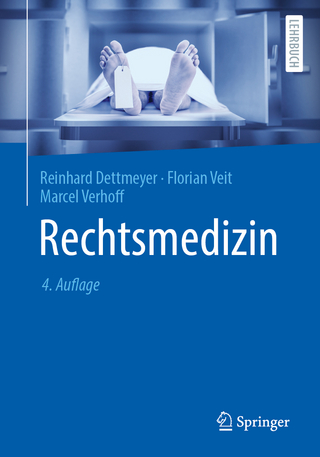
New Perspectives in Forensic Human Skeletal Identification
Academic Press Inc (Verlag)
978-0-12-805429-1 (ISBN)
The contributing authors represent established experts in forensic anthropology and closely related fields. New Perspectives in Forensic Human Skeletal Identification will be an essential resource for researchers, practitioners, and advanced students interested in state-of-the-art methods for human identification.
Dr. Latham is an Associate Professor of Biology & Anthropology and serves as the Director of the Molecular Anthropology Lab and the Co-Director of the Archaeology & Forensics Laboratory. A Board Certified Forensic Anthropologist (D-ABFA), she currently serves as a Consulting Forensic Anthropologist for police, coroners and pathologists in the Midwestern United States and has delivered numerous lectures for state and local agencies around the country. Dr. Latham also serves as a DNA Expert in the U.S. Federal Court System. Dr. Bartelink is an Associate Professor of Physical Anthropology and serves as the Director of the CSU-Chico Human Identification Laboratory (CSUC-HIL), the Stable Isotope Preparation Laboratory (SIPL), and co-coordinator of the Certificate in Forensic Identification. He is a board certified Diplomate of the American Board of Forensic Anthropology. In addition to teaching undergraduate and graduate level coursework in introductory physical anthropology, human osteology, forensic anthropology, bioarchaeology, human growth and development, and statistics, his is a certified instructor for POST (Peace Officer Standards and Training), and teach short courses and workshops in forensic anthropology, forensic archaeology, and human versus non-human bone identification. He is also a forensic specialist for California’s NamUs team (National Missing and Unidentified Persons System). Dr. Finnegan is Professor Emeritus of Anthropology, at Kansas State University, and one of the nation's leading forensic anthropology experts. In 2005, he was named a Distinguished Fellow of the American Academy of Forensic Sciences. He holds a Ph.D. in Anthropology from the University of Colorado and held a postdoctoral fellowship at the Smithsonian Institution, studying paleopathology and non-metric variation for population studies and forensic science application. He is a Fellow and past Vice President of the American Academy of Forensic Sciences; a Diplomate, and past President, of the American Board of Forensic Anthropology and is a recipient of the "Kansas Attorney General's Certificate of Merit" in recognition of outstanding service rendered to law enforcement in and for the State of Kansas by a private citizen. He has published numerous articles on theory, method and application of osteological analysis in population studies and forensic applications. He has conducted research in Africa, Australia, the Middle East, Southeast Asia, and Europe, as well as various areas of North and South America. Dr. Finnegan is a recipient of the "William L. Stamey Teaching Award" in undergraduate instruction, the "John C. Hazelet Award" as the outstanding member of the Kansas Division of the International Association for Identification, the "Bartucz Lajos Award" from Jozsef Attila University and the "T. Dale Stewart Award" from the American Academy of Forensic Sciences.
1. Introduction
Section I: Advances in Biological Profile Construction 2. Human Variability and Forensic Anthropology 3. Advances in Morphometrics for Sex and Ancestry Assessment 4. Advances in cranial macromorphoscopic trait and dental morphology analysis for ancestry estimation 5. hu(MAN)id: an R-based Application and GUI Utilizing Linear Discriminant Analysis for Classifying the Human Mandible 6. A Decade of Development in Juvenile Aging 7. Estimation of Immature Age from the Dentition 8. Adult Age-at-death Estimation in Unknown Decedents: New Perspectives on an Old Problem 9. Multivariate regression methods for the analysis of stature 10. Full Skeleton Stature Estimation 11. The History and Use of NamUs
Section II: Advances in Molecular and Microscopic Methods of Identification 12. The Utilization of Databases for the Identification of Human Remains 13. Flexibility in Testing Skeletonized Remains for DNA Analysis Can Lead to Increased Success: Suggestions and Case Studies 14. Forensic identification of human skeletal remains using isotopes: A brief history of applications from archaeological dig sites to modern crime scenes 15. Stable Isotopes Analysis: Case Applications 16. Bomb Pulse Radiocarbon Dating of Skeletal Tissues 17. Species Determination from Fragmentary Evidence 18. Bone Histology as an Integrated Tool in the Process of Skeletal Identification
Section III: Advances in Radiographic and Superimposition Methods of Identification 19. Overview of Advances in Forensic Radiological Methods of Human Identification 20. Advances in the use of frontal sinuses for human identification 21. Advances in Radiographic Superimposition 22. Comparative Medical Radiography: Practice and Validation 23. The CADI Method of Computer-Assisted Radiographic Identification 24. Morphometric Identification Methods
Section IV: International Studies and Mass Disasters 25. International Advances in Identification of Human Remains 26. Using Elliptical Fourier Analysis to Interpret Complex Morphological Features in Global Populations 27. Forensic Anthropology and the Biological Profile in South Africa: Recent Advances and Developments 28. The Influence of Operational Workflow and Mortuary Environment on Identification 29. Advances in Disaster Victim Identification 30. Summary
| Erscheinungsdatum | 14.08.2017 |
|---|---|
| Verlagsort | San Diego |
| Sprache | englisch |
| Maße | 216 x 276 mm |
| Gewicht | 1400 g |
| Themenwelt | Medizin / Pharmazie ► Medizinische Fachgebiete |
| Studium ► 2. Studienabschnitt (Klinik) ► Rechtsmedizin | |
| Recht / Steuern ► Strafrecht ► Kriminologie | |
| ISBN-10 | 0-12-805429-8 / 0128054298 |
| ISBN-13 | 978-0-12-805429-1 / 9780128054291 |
| Zustand | Neuware |
| Haben Sie eine Frage zum Produkt? |
aus dem Bereich


